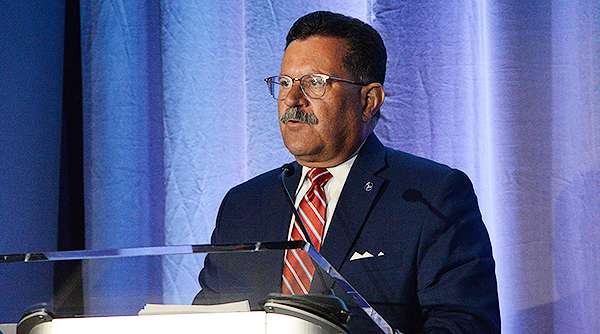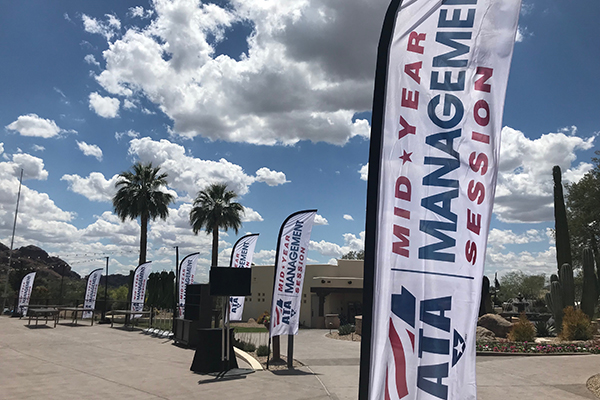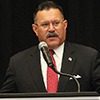FMCSA’s Ray Martinez: Industry Collaboration, Data Play Key Roles in Agency’s Work

SCOTTSDALE, Ariz. — The Federal Motor Carrier Safety Administration is focused on improving infrastructure and creating common-sense regulations, and open communication with the trucking industry enhances the government’s efforts.
Ray Martinez, FMCSA administrator, made the remarks while addressing trucking industry executives at American Trucking Associations’ midyear management meeting.
“My work at FMCSA depends on clear and honest communication with you as close to real time as possible,” Martinez said.
He added that over the past year, the relationship between FMCSA and the industry has grown, resulting in a more positive and collaborative relationship.
“It helps us make better decisions,” he said, adding that constant communication also provides insight into unintended consequences of well-intentioned actions FMCSA takes to meet its mandated obligations and safety mission.
During the session, Martinez outlined FMCSA’s top priorities. He said the agency is working on rebuilding and refurbishing infrastructure, particularly roads, bridges and tunnels, and noted that 1 out of every 5 miles of highway pavement is rated in poor condition.
Martinez told attendees President Donald Trump and Transportation Secretary Elaine Chao are working with Congress on infrastructure investments. “We all agree infrastructure is important,” Martinez said, adding that this is a national issue as well as a local one.
“It is also local because it is your representatives in Washington that need to understand what the stakes are,” he said. “We are all in on this, and I hope you will be fully engaged.”
Truck parking concerns often are raised in infrastructure discussions, and Martinez said FMCSA is engaged on the topic with partners on the federal level.
“Insufficient truck parking is a safety issue for us,” he said. “We all want well-rested drivers.”
However, building new truck parking isn’t the only solution. “It is about leveraging the technology we have to make sure we use the parking spaces that are currently available,” he said.
Anytime that you change a law, regulation, guidance or standard operating procedure, and then add in new technology, it is going to take time and a commitment to see it through.
Ray Martinez, FMCSA administrator
Electronic logging devices remain a top issue within the industry, and Martinez said FMCSA recognizes this is a transitional period for the trucking industry as well as law enforcement.
“Anytime that you change a law, regulation, guidance or standard operating procedure, and then add in new technology, it is going to take time and a commitment to see it through,” he said.
Since the ELD mandate took effect, less than 1% of driver violations have been for the driver not having an ELD or automated onboard recording device, which are allowed through December. Hours-of-service violations are down 52%, Martinez said.
“These are good indicators, and I think they’re going to get better,” he added.
What’s more, ELD implementation has opened the door for FMCSA to look at hours-of-service requirements.
“It is an appropriate time to do it. Commerce has changed. Technology has changed,” Martinez said.
The industry has said it needs more flexibility on HOS, and Martinez said he and the secretary have gotten the message. FMCSA held five public listening sessions and received more than 5,200 comments on the docket. Most importantly, those comments included data. “That is the type of feedback I needed,” he said.
FMCSA obtains its data from external sources, and Martinez said the best data the agency has comes from industry.
“We want to have a conversation with the industries that have the information,” the administrator said.
The Office of Management and Budget is reviewing proposed hours-of-service changes. The proposal is expected to be released in June, but OMB could request more time. Once it comes back, it will be published for comment.
“Our mission is safety. The changes we have proposed are tied very, very closely to what we can actually point to as data, from existing data to publicly available information, to create this better and more flexible environment,” Martinez said.

The ATA's Midyear Management Session was held in Scottsdale, Ariz., this year. (Mindy Long/Special to Transport Topics)
He said FMCSA is continuing to move forward with the drug and alcohol clearinghouse and is on track to complete the federal portion of the mandate by the January 2020 compliance date.
“Part of ensuring safe commercial motor vehicle operation is making sure both new and experienced drivers are drug and alcohol free,” Martinez said. “The clearinghouse will move us closer to that goal.”
FMCSA has been working on a safety scoring/crash preventability demonstration program, and Martinez said the goal is to have more to share soon.
“We’re working aggressively to see if we can come up with a better mousetrap, a better predictor and a better tool to see where we should be targeting resources,” he said.
The program is in the pilot phase.
“The whole idea was to prove this out,” Martinez said. “We will be continuing this program and adding additional crash categories for consideration. Additional information will be published this summer.”
The agency hasn’t identified the other crash preventability areas it could include.
“It is something we’re going to engage with the industry to say, ‘What other buckets should we add?’ They have to be reasonable. It can’t be an impossible task,” he said.
The economy and job creation are on the rise, making this is an exciting time for the United States and the trucking industry, Martinez said.
“The trucking industry is a critical part of this economic boom,” Martinez said, adding that there are 7 million employees within the industry. “The president, leadership and FMCSA understand that you are the job creators.”





